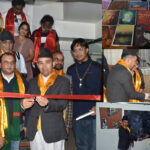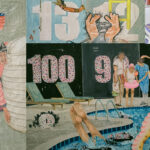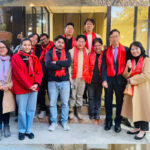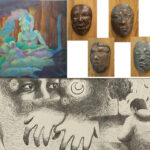The agricultural lands, which is home to crops and the insects are in the verge of extinct due to the growing urbanization. The insects like grasshopper, bugs are declining day by day as people have stopped working in the field and are using insecticides and pesticides in great amount that results in increase in production of crops but has a harsh effect on those insects.

In this very context, a young and promising printmaker Bidhyaman Tamang is trying to bring the relationship with soil and insects to the audience through the print-making art. He is exhibiting his prints, under the title ‘My Memories of the Soil’ at Siddharth Art Gallery, Babarmahal. Tamang, who was born in Ramechhap, has a vivid memory of his days in school and says – ‘Choosing to be an artist was not a good decision then, It was thought that art is only for weak students. However, I was interested in art. But I did not want to say that I will become an artist and study art.’
He started studying management after school but continued to pursue art on his own. He never left the subject he was interested in. Due to his hard work and tireless perseverance, he has now succeeded in exhibiting his art at the Siddharth Art Gallery.

Ever since he was in school, he was fond of drawing and would constantly draw pictures in his copies. After passing intermediate level, he started decorating the walls of his room by the paintings that he made. When one of his brothers saw his paintings, he said, ‘A person who makes such good paintings should study Fine Arts. Thus his journey of making art got a new beginning from the Lalitkala Campus in Kathmandu. He used to make different types of paintings during his art studies.
He experimented in different mediums and modes of painting back then, ranging from sketch book, canvas and so on. In those days, he used to consider printmaking way too complicated. Slowly and gradually, under the guidance of his tutor Sauraganga Darshandhari, he started getting encouragement to do many experiments in printmaking. She also paired him with another student Aman Maharjan who used to study in Srijana College of Fine Arts and had similar kinds of ideas. They both worked together, experimented in different mediums and learnt from each other.
After completing his graduation, he went to stay in village for some time. At the same time an organization called ‘Bindu’ called for a residency and organized a printmaking workshop for about 3 months. He came to Kathmandu from Ramechhap to participate in it. After that, he started getting more interested in printmaking and thought that the necessity of doing more experiments in prints. He got ample opportunities to sharpen his knowledge and skills during that workshop.

Even after that, he continued to work in various workshops. Sometimes as a volunteer and sometimes as a participating artist. His printmaking works also started grooming due to his persistence and intensive study. But he had to do more and more experiments in this genre.
For choosing theme of this exhibition, he remembers his the conversations with his grandmother. She used to tell him that the insects and grasshoppers that she saw in her young age are slowly disappearing. The reason behind this is that the green and arable land has turned into concrete piles. Grandmother used to tell about the biological cycle of insects, which appear during cultivation on arable land. Grasshoppers, the gift of nature, also have their own importance and because of these insects, diseases are not spread in the crops.
He reviewed the same topics and brought the current works to refresh those memories. During his post-graduation, he says that he got the opportunity to learn new ways from his guru Seema Shah. During the post-graduation, they have come here by going to their masters’ houses and learning the work or learning the different methods of different artists. At the Kathmandu Triennale held in 2022, he kept the pictures of those insects in a box and showed them in a way that they could be seen from outside the glass. Many people liked that job very much at that time. Sangeeta Thapa, director of Siddharth Art Gallery, also liked his work very much. That’s why she nominated him for the Australian Himalaya Award and fortunately he got the award. He made good use of his award by reminiscing about his childhood, conversations from his grandmother and connecting insects with agriculture. But when he received the award, the lockdown was going on in Nepal due to the corona pandemic. Although it was very difficult to buy the necessary materials for printmaking, the existing ones continued to do their work. The combination of the new experiments he did take a tangible form, a big collection was made.

For the first time, he had the opportunity to exhibit the contemporary arts born from those experiments and creations at Siddharth Art Gallery through a solo art exhibition. Which can be an opportunity for art lovers to observe new experiments closely. Bidhyaman, who is making new experiments to improve the printmaking he is doing, keeps maps on the back of his printmaking. While talking about the reason for keeping it, he says, “Currently, people’s relationship with the soil is gradually disappearing. Farming lands have gradually started to be occupied by houses. “I think Lalpurja or maps are the best way to show our relationship with the soil,” he says.The printmaking works made by him look very different and attractive from the works made by the generation before him. While talking about it, Bidhyaman says that he spends a lot of time on the pictures before printmaking. Even after the pictures are good, he says that this difference in his works has come from thinking about how they can be displayed in a better way by making other uses.
He takes needles as the material he needs for printmaking and says that he always has a set of needle in his purse and bag. After becoming an artist, he believes that people should present the things they see in a different way. Sometimes he weaves the stories of a thirsty city in his paintings, sometimes the practice of making natural pesticides by putting garlic in the middle of the corn stalks used in agriculture by his grandmother, and sometimes playing in the village environment when people are going to shepherd or to make a living. People like Baghchal and his group draw pictures about how they are controlled by power. In the future, he plans to create a studio and bring more artists interested in printmaking together to do more sophisticated works, just like how groups work together in printmaking abroad. The art exhibition will run from November 11th to 29th.







Leave A Comment